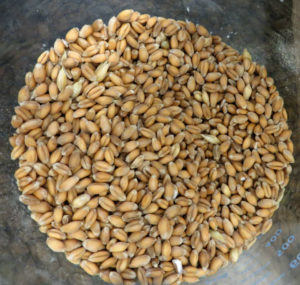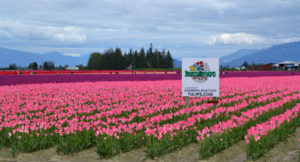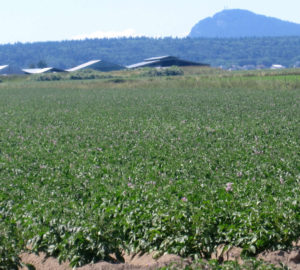Malting! As a kid, it meant malted milkshakes and Whoppers–malted milk covered in chocolate. Ugh! Whoppers were the rage in my Trick or Treat bag, but they tasted awful.
Now I savor a malted drink–Hefeweizen–the German malted wheat beer of my heritage. I like Lagers, IPA’s, and whiskey–all malted. I even add a quarter cup of Nestlé Malted Milk powder to my pancake mix. Yum! But, what is malting?
Malting is…

Wheat varieties at the Munich Botanical Garden
Malting is an age-old process, fostered first in ancient Egypt about 6,000 years ago where kernels of barley, wheat, rice or other cereal grains are germinated in water. When the shoot reaches about 3/8 of an inch, germination is abruptly stopped and the sprouted kernels are oven-dried. Depending on the timing and the oven temperature, the dried grain develops differing flavors. The sprouting and drying process allows the grains’ starches to develop sugars, which the palate desires. Up until last century, the malting process was labor intensive. Damp, sprouted grains were spread out on cavernous floors, heated from below, and the grains were turned manually with large rakes until dry. With the advent of mechanization, malting grains were commoditized and standardized.
All superior beers are crafted with malted grains–most often barley or wheat–and then water, yeast and hops are added to the mix. Budweiser is produced from unmalted grains–either corn or rice. (No wonder when my German cousins visited when I was a kid and couldn’t stomach American beer!) Beer aficionados probably already know that mainstream beers are unmalted, but my being only a casual drinker of a good, well-crafted, specialty beer on a hot summer eve, I now know why I like crafted beers! It’s the brewed combination of malted grains, tangy hops, fermented yeast, and cold spring water.
A New Malting Dawn
Now, a new malting dawn is rising an hour north of Seattle in Skagit County, home to Skagit Valley Malting, Dr. Stephen Jones of Washington State University, and a multitude of folks all working to ensure that the region reigns as a preeminent, world class agricultural powerhouse, with products that create flavor, value, and terroir–a sense of place.

Grains ready for malting
Imagine my amazement when Wayne Carpenter of Skagit Valley Malting said, “there are 15,000 varieties of barley and 20,000 strains of wheat that can be malted!” Just in barley varieties, there are black, purple, red, and many shades of gold. Astonishingly today, in American beer brewing, including the craft brewers, only 10 barley strains are malted according to the American Malting Barley Association. Further, over the past 30 years, barley acreage has dropped 77%. This leaves a multitude of grains to test in the Skagit soils, to create the finest flavor, foster the hardiest plant, find the biggest producers, create the preeminent malts and build the agricultural economy. Dr. Stephen Jones is the Director of WSU Research in Mt. Vernon, the heart of Skagit County in the Department of Crop and Soil Sciences with his research concentrating on improving wheat and grain varieties and to support the growing Skagit grain economy.

Skagit County is home to the annual April Tulip Festival
Historically, prior to the United State’s commoditization and consolidation of agriculture following World War II, the Skagit agricultural lands had record wheat yields, two times those found on the Palouse Hills of eastern Washington and three times those found in Kansas, which hails as the Wheat State, since it grows more wheat than any state in the Union. Despite the fact that Skagit County lost their wheat and barley markets, the farmers have to grow grains because it is a necessary rotational crop in a healthy agricultural ecosystem. By including grain in a field planting sequence, disease and pest cycles are broken.

Skagit specialty red potato fields
For example, if potatoes are grown in a field in year one, that same acreage cannot be planted with potatoes until year four. Other crops, such as tulips, grasses, cabbages, cucumbers, and grains can be rotated in. By not planting a field with potatoes again, harmful insects or diseases never get to call that acreage “home” and move in and multiply. No matter what though, by year three, a grain planting cycle is a necessary rotation to maintain soil health, because it returns organic matter to the soil, and the deep root system (about the same height as the stem and wheat spike) breaks up clay soils, allowing natural soil aeration. However, grain rotations are not as profitable for the farmer with gross earnings between $500 to $1,000 per acre ($0.01 to $0.02/square foot). When compared to peonies ($52K/acre or $1.19/SF), tulips ($15K/acre or $0.34/SF) or the specialty crop Skagit Red Potatoes ($12K-$15K/acre or $0.34/SF to $0.28/SF), grains have been downright a money loser.
Now Skagit Valley Malting is selling their malted grains to breweries in Washington, DC, where premium beers are sold at $21 per pint. Pike Brewery in Seattle sells specially crafted beers brewed with Skagit malts. Malting is not only for beer, but for bread, too, such as the loaves at the Breadfarm in Bow, Washington, Chad Robertson’s Tartine Bakery in San Francisco, and Manhattan’s Blue Hill restaurant–all featuring malts from Skagit Valley Maltingt!
Opportunity in malting!
Skagit farmers, entrepreneurs, agricultural researchers, and others see opportunity! Beer drinkers rejoice! The Skagit region is charging ahead as an economic agricultural powerhouse in the changing edible landscape. Eaters and drinkers everywhere are looking for new, wholesome, and vibrant taste experiences. Growing grains is getting exciting and is expected to be a money maker!
Kathryn Gardow, P.E., is a local food advocate, land use expert and owner of Gardow Consulting, an organization dedicated to providing multidisciplinary solutions to building sustainable communities. Kathryn has expertise in project management, planning, and civil engineering, with an emphasis on creating communities that include food production. Kathryn is a Washington Sustainable Food and Farming Network board member and a member of the American Planning Association’s Food Interest Group. Kathryn’s blog muses on ways to create a more sustainable world.


Hi, Kathryn. Thanks for the excellent report on malting in Skagit Valley. I wanted to point out that besides brewers and bakers, distillers are also big users of malted grain. Scotch whisky is made from 100% malted barley, and other types use various combinations.
Besides the many craft distilleries that are popping up, there is a movement to legalize hobby distilling, which would lead to a business boom similar to what happened when home beer brewing was made legal.
Rob–Thanks so much for letting me know about the new possibilities for malting. Wayne Carpenter mentioned that Scotland–the home to Scotch (whiskey)–is another malting region in the world.